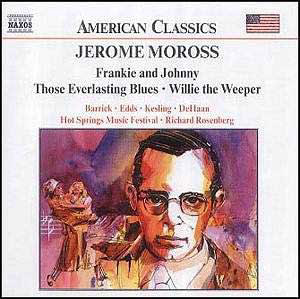To many, Jerome Moross will be better known as the
composer of some very fine film scores and particularly of the large-scale
epic The Big Country (1958). However, he also wrote a
good deal of concert works such as his late Sonata in G major
for piano duet and string quartet of 1975 (once available on BAY CITIES
BCD 1014) and his First Symphony which was first performed in 1943 under
the direction of none other than Sir Thomas Beecham.
Those Everlasting Blues on words by
Alfred Kreymborg was completed in 1932 (the composer was nineteen years
old) and first performed in a concert conducted by Henry Cowell. As
may be expected, the music is clearly attempting at reproducing some
traditional Negro Popular Song. The range of the vocal part is deliberately
limited and calls for some guttural vibrato redolent of Gospel singing.
An entertaining minor work well worth the occasional hearing.
Frankie and Johnny (or The Ballad
of the Scandalous Life of Frankie and Johnny, to give it its full
title) is a ballet score on a libretto by Michael Blankford and the
composer based on an actual event that occurred in St Louis in 1899.
This is a somewhat hybrid work in which a female vocal trio acts in
the manner of a present-day Greek Chorus embodied here by Salvation
Army girls wandering about the stage and playing tambourine, bass drum
and cymbals while narrating the events of the story. The music is quintessentially
American, tuneful, colourful and superbly scored, often alluding to
some forms of popular music. A most enjoyable and entertaining work,
though it has its moments of real emotion as in the final Funeral
Party One-Step which concludes the piece in simple, moving terms.
Many of its qualities and characteristics also predominate
in Morossís somewhat more elaborate dance cantata Willie the Weeper
written in collaboration with librettist John Latouche with whom Moross
co-operated on several occasions. It actually is the central panel of
a triptych Ballet Ballads consisting of three one-act
dance cantatas combining dance, song and story-telling, however without
any spoken dialogue. The piece is scored for tenor, chorus and orchestra,
though it seemingly has often been performed with piano. Moross nevertheless
clearly intended his orchestrations to be performed. The music again
abounds with catchy tunes, lively rhythms and many orchestral niceties;
and is also often redolent of popular music of its time. It is a substantial
score that definitely deserves to be heard. (By the way, I now really
wonder what the other panels of Ballet Ballads sound like.)
Morossís often ostinato-based music is straightforward,
full of catchy and memorable tunes, with many jazz-inflected phrases
and rhythms. It is superbly crafted and his orchestral flair is evident
throughout. All concerned here make the best of these attractive and
little-known scores. American Classics, maybe not so, but I enjoyed
every minute of this delightful release.
Hubert Culot


